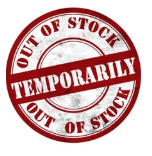In a recent survey, when asked what aspect of their Amazon business they wanted to improve in 2020, an overwhelming number of the respondent sellers said inventory management.
Why?
Because having a healthy inventory position is the cornerstone for any thriving Amazon business.
On Amazon, being out-of-stock can have a serious long-term, negative impact on a seller's product listings and future sales.
Unlike in a brick and mortar retail store where a seller who runs out of a particular item faces only the loss of a sale (and can even "rain-check" a customer), on Amazon, a seller can’t accept orders for backordered items.
 If they're at zero stock, their listing goes down and sales simply stop coming in until they have the product back in stock, and they fall behind in the SERP*.
If they're at zero stock, their listing goes down and sales simply stop coming in until they have the product back in stock, and they fall behind in the SERP*.
And if this occurs too often, it can lead to an Amazon ban.
Being out of stock for a long period of time, or very often, affects a seller's search results. Amazon relies on many factors when delivering search results to consumers, and product availability plays an important role in their search ranking algorithm.
When sellers are out of stock, their listings usually won’t show up at all in Amazon search. And if they're out of stock often, they will find their listing(s) knocked down in the rankings regularly, even when they do have products available.
Product and seller reviews also take a hit when sellers' products are out of stock. No sales equals no new seller reviews from buyers. Additionally, buyers are unable to leave new product reviews to listings that don’t show up when searched.
Continuously getting new reviews and ratings is vital to Amazon sellers, because newer reviews boost search results. Also, listings with fresh reviews attract and convert more buyers. When a seller's inventory is zero, they lose traction by missing opportunities for new reviews and ratings.
* (Search Engine Results Pages [SERP] are the pages displayed by search engines in response to a query by a searcher.)
Efficient product inventory management helps Amazon sellers keep their products in stock and sales flowing. With a sound inventory management process in place, sellers will be able to more effectively strike the optimal balance between satisfying buyer demand and maintaining ample inventory.
But this takes more than simply counting products and listing quantities in Seller Central. Order volume, cash flow, and sales forecasting all play a role, and sellers must master the entire process in order to stay at the top of Amazon’s search listings and to drive sales.
Sellers who manage their Amazon inventory...
- Attract online shoppers and make sales. Those sellers who constantly run out of stock, watch their customers buy from their competitors.
- Reduce inventory costs. They avoid being charged inventory storage overage fees or being faced with limited storage access because they know what items to restock and the appropriate times to do so.
- Limit inventory losses. Sellers who constantly monitor their inventory levels, can limit losses from mismanaged storage and receiving errors.
 Inventory management requires precise forecasting calculations in order to determine when to order more inventory and how much, while also taking into consideration any lead times that are in place with suppliers.
Inventory management requires precise forecasting calculations in order to determine when to order more inventory and how much, while also taking into consideration any lead times that are in place with suppliers.
As part of an Amazon seller's shipping plan with Amazon, he or she must specify which products they want to send to Amazon, the quantity of each product, the shipping method and carrier details, and whether or not they want to prep and label the inventory themselves or have Amazon do it.
When creating an individual plan, sellers should be sure to leverage historical data, yearly run rates, and sales performance during peak shopping times (holiday season), to help forecast inventory.
The goal is to sell out old inventory before placing a new one. Despite this goal, sellers would be prudent to keep a certain amount of "just in case" stock on hand to fulfill any unexpected orders or supplier delays.
Understanding when not to replenish products is just as critical for sellers as knowing their top-selling ASINs. Sellers shouldn't just blanket reorder their entire catalog. Instead, they should make their selections on a SKU-by-SKU basis, to avoid replenishing low margin, low velocity products that are compromising their profits.
Also, sellers should take units ordered, profit margin, Buy Box share, returns, and sales rank into consideration to determine how many units of each SKU they should plan on ordering, based on both current demand and seasonal trends.
Types of Inventory:
- High sales / High profit – Products that sell quickly and generate higher than average profit margins. (Keep these items in stock 100% of the time.)
- Low sales / High profit – These products have smaller sales but generate higher than average profits. (Sellers may want to lower the price on some of these items to deplete them faster.)
- High sales / Low profit – These are fast-selling products, but they yield lower than average profits. Sellers must decide which items are worth keeping and which ones do not make sense to replenish.
- Low sales / Low profit – These products do not sell quickly and do not generate much profit whatsoever. Sellers should use peak shopping times such as the holiday season to liquidate these products and invest in other items that perform and generate a higher profit.
In order to succeed at inventory management, sellers should first do their due diligence to understand and monitor their Inventory Performance Index (IPI) if they are operating within an FBA business model.
Understanding Your IPI
Amazon’s IPI metric is based on excess inventory, sell-through, stranded inventory, and in-stock inventory.
- A seller's IPI score combines three months of historical sales, inventory levels, and costs into one metric and helps the seller to identify how well their FBA inventory is performing, where there is room for improvement, and if he or she is eligible for unlimited storage.
- Currently, it is used to limit storage access if a seller's has an index score below 350. If a seller does not maintain an IPI above 350, they will be notified by Amazon of potential storage limits, which are analyzed on a quarterly basis. If their score doesn't move above the 350 threshold at the end of the quarter, the limits will still apply for the next quarter.
- If their existing inventory exceeds their storage limits for a particular month, they will also need to pay an inventory storage overage fee on the inventory that goes above the limit, as well as applicable monthly and long-term storage fees. Also, they will not be able to create a new shipment to Amazon until their inventory level drops below the limits.
- The overage fee will be charged monthly at $10 per cubic foot, based on the daily average volume of inventory that exceeded the limits over the course of the month. Maintaining 30 to 90 days of inventory coverage should keep a seller in good standing for a strong IPI.
- Sellers should make sure that their IPI score is where they want it to be prior to any significant time periods on Amazon, such as the holiday season. By doing so, sellers are ensuring that they have the maximum amount of storage and that their sales will not be suppressed as a result.
How to Improve Your IPI Score
To improve their IPI score, sellers should look at slow-moving, excess, and sell-through inventory to determine how they can get those ASINs to move faster ahead of peak selling periods.
Focus on resolving stranded inventory before it becomes unsellable and Amazon requires that it be removed from FBA warehouses. Amazon bases its quarterly storage limits on a seller’s sales volume, historical IPI scores, and available fulfillment center capacity.
When setting limits for the upcoming quarter, a seller’s recent sales volume and seasonal volume from the past year are considered.
Storage limits are applicable for six storage types: standard-size, oversize, apparel, footwear, flammable, and aerosol products, and Amazon assigns one storage type per item based on its characteristics.
How to Successfully Manage Your Amazon Inventory
 1. Use Amazon Inventory Management Tools to Track and Maintain Inventory Levels
1. Use Amazon Inventory Management Tools to Track and Maintain Inventory Levels Amazon’s Seller Central dashboard has a suite of built-in tools that sellers can access for free.
The manage inventory tool allows sellers to view data about their products. Sellers can access this information and download reports to help them to make better decisions about their inventory.
The manage inventory screen allows sellers to do the following:
- Add products
- Change pricing
- View seller fees for each product
- Change quantity
- View active, inactive, and suppressed listings
- Track FBA shipments at every stage
- View FBA or merchant-fulfilled stock levels
Amazon Selling Coach
Within the dashboard, the Amazon Selling Coach reports key inventory data to help sellers track inventory levels and purchasing needs.
The Amazon Selling Coach has powerful, and often under-utilized, inventory management tools that allow sellers to review sales trends for their products and see Amazon’s estimate for the number of days their current inventory levels can cover. This helps sellers to accurately forecast their inventory purchases based on actual sales data.
The Amazon Selling Coach also sends sellers Low Stock Alerts via email or to their mobile Amazon Seller App. These let sellers know when it’s time to reorder based on the lead times that they have set for each product. This helps to minimize zero-stock status and avoid lost sales and lower search rankings.
By tracking their sales and inventory trends, Amazon inventory management tools show how much of each product is sold on Amazon on a daily, weekly, and monthly basis. Sellers can then plot out trends to determine required inventory levels for products over different periods of time.
This comprehensive look at sales and inventory trends is key to making sound purchasing decisions.
Inventory Health Report
Sellers access this report by logging into their Seller Central account then clicking on reports 🡪 fulfilment by Amazon 🡪 inventory health. From there sellers can view their total unsellable quantity* and total sellable quantity of all their products.
This section has all the information on the movement of a seller’s inventory. The inventory health report shows how many units have been sold in the last 30 days, and weeks of cover based on a seller’s previous 30 days of sales.
It also shows the lowest competing price for each product listings. Having this information allows a seller to be able to study their current sales velocity and inventory health.
This data can be used to determine what products sell at different times of the year, facilitating planning for the next calendar year.**
If a seller’s account has any recommendations for removals, access the recommended removal report. There is an option to have products returned, liquidated or removed before the seller is charged a long-term storage fee.
* (Unfulfillable inventory = unsaleable inventory. When FBA shipments are sent to the fulfillment center, each item in the shipment is reviewed for quality and quantity. If Amazon determines that an item is damaged, they consider it unfit for sale or shipment. They will mark the item as Unfulfillable. These items can be removed automatically or returned back to the seller.)
** (It is best to stock up on inventory of fast moving products which have a high demand all year round. The stock for seasonal products should be kept to a minimum.)
 2. Use Lead Times & Forecasting to Plan Inventory Orders
2. Use Lead Times & Forecasting to Plan Inventory OrdersWhat is Inventory Order Lead Time?
Lead time is the time it takes for inventory to arrive once it has been ordered. Knowing lead times helps sellers to determine how often they need to order inventory to cover orders over a given period of time and the appropriate quantity.
Sellers who understand their supplier lead times can avoid…
- Over-ordering – which ties up cash in more inventory than needed.
- Ordering too late – running the risk of hitting zero inventory before new stock arrives.
What is Inventory Forecasting?
Predicting how much inventory is needed when a seller places an order is called inventory forecasting. Forecasting bases a seller’s re-order quantities on their sales trends and inventory levels. Sellers, however, also need to use their intuition and experience when placing orders based on forecasted numbers.
The holidays, new trends and seasonal periods can affect inventory requirements higher or lower. Sellers should consider these factors along with lead times, in their decision-making process.
3. Sellers Should Understand Their Supply Chain Lead Times
Supply chain refers to inventory movement from initial sourcing to arrival in a warehouse. By understanding your supply chain and lead times, you can identify the who, what, where, and when involved in sourcing, receiving, and storing your Amazon inventory.
To keep the supply chain running smoothly, a seller must stay on top of their suppliers’ manufacturing and delivery schedules and have contingencies in place for worst-case scenarios.
This is particularly important if a seller uses overseas suppliers since shipping delays can take weeks to resolve. Sellers should hold some inventory in reserve to cover unexpected delays along their supply chain if sourcing goods overseas.
4. Sellers Should Understand Their Inventory Turnover Rate
To calculate their inventory turnover rate, sellers need to know, on average, how fast their products are selling on Amazon. With this information, they can estimate how much inventory will be needed to maintain inventory levels between inventory shipments.
5. Be Strategic with Promotions and Sales
A sales spike due to a great promotion can drain inventory before the next delivery and leave a seller with zero stock, angry customers, and a lower Amazon ranking.
One way to prevent this is to set a threshold for a set number of promoted products in a seller’s inventory. Once that number is reached, the promotion can be halted, and the remaining inventory sold at a higher price to avoid running out completely.
If a seller plans to sell out completely, he or she should be sure to set a threshold amount that covers four hours of promotional sales (determine that number in Seller Central).
Four hours is the key here because Amazon takes up to four hours to remove a promotion once it is stopped. This gives the seller adequate inventory to cover sales that come in after the promotion has stopped.
Another way to hold a successful promotion is to order a reserve of the promoted products from the supplier with a future ship date. If the promotion is successful and the shipment is needed quickly, the seller can contact the supplier to move up the shipment date. But if the promotion lags, the seller can cancel or extend the shipment date of the restock order to avoid being overstocked.
 Managing your product inventory is one of the most important tasks to be done in order to be successful as an Amazon seller. Don’t make the mistake of ignoring your inventory health.
Managing your product inventory is one of the most important tasks to be done in order to be successful as an Amazon seller. Don’t make the mistake of ignoring your inventory health.
It takes time to earn a good reputation as an Amazon seller, and sellers can’t afford to lose their reputation or hard-earned rankings because of poor inventory management.
Sellers moving a few products have vastly different inventory needs compared to multichannel sellers who stock and re-order products in volume. Whatever your sales model, it’s vital that you understand the problems you face when you let your inventory run out, and how you can prevent this from happening.
Use the above tips as a guidelines for keeping your inventory at manageable levels in order to stay competitive on Amazon.

.png)









